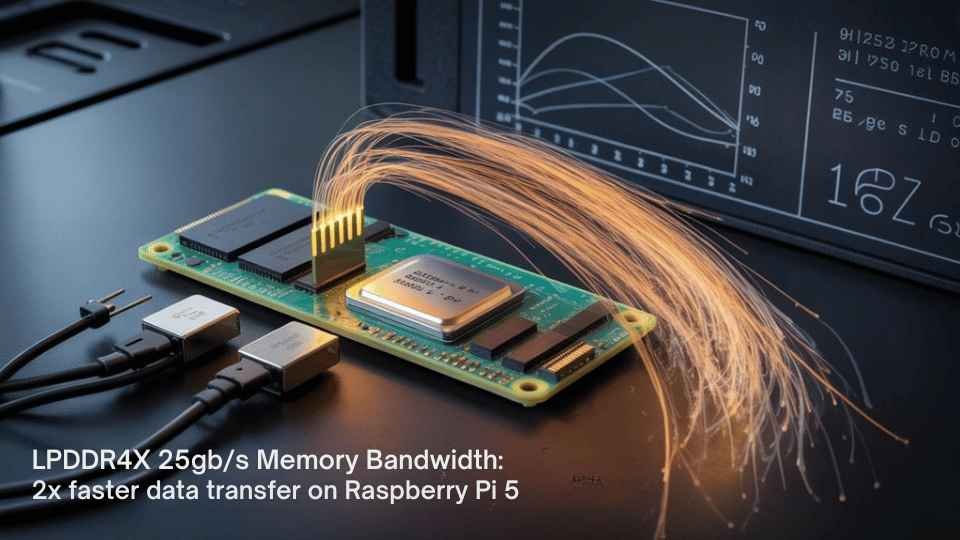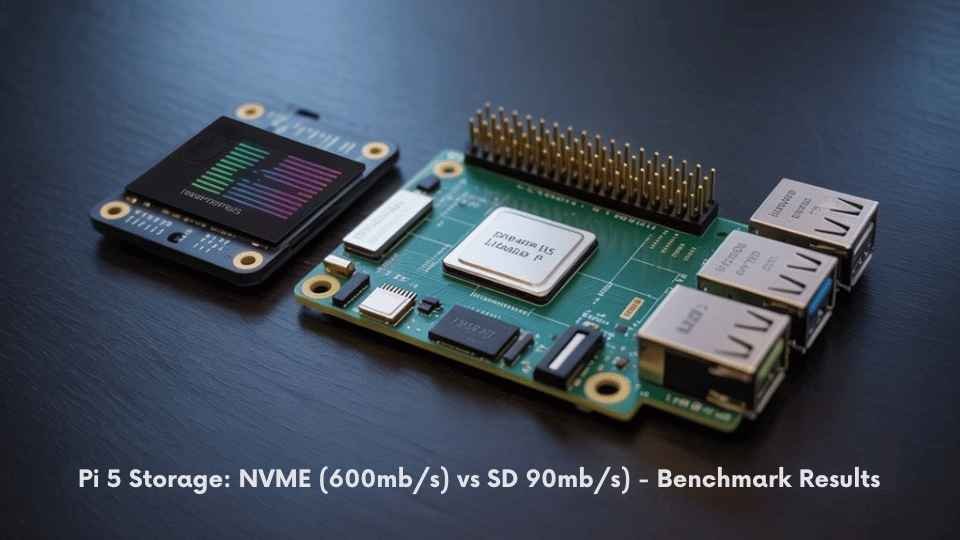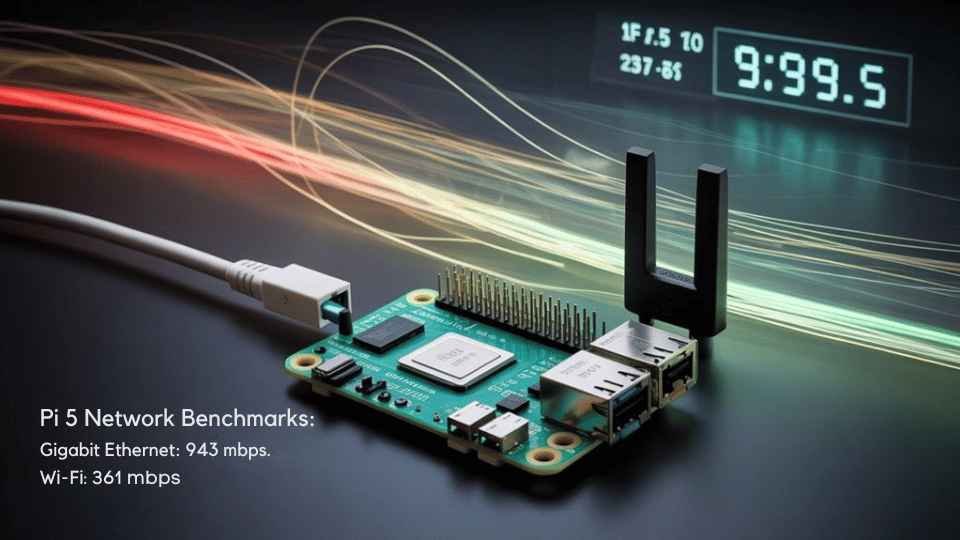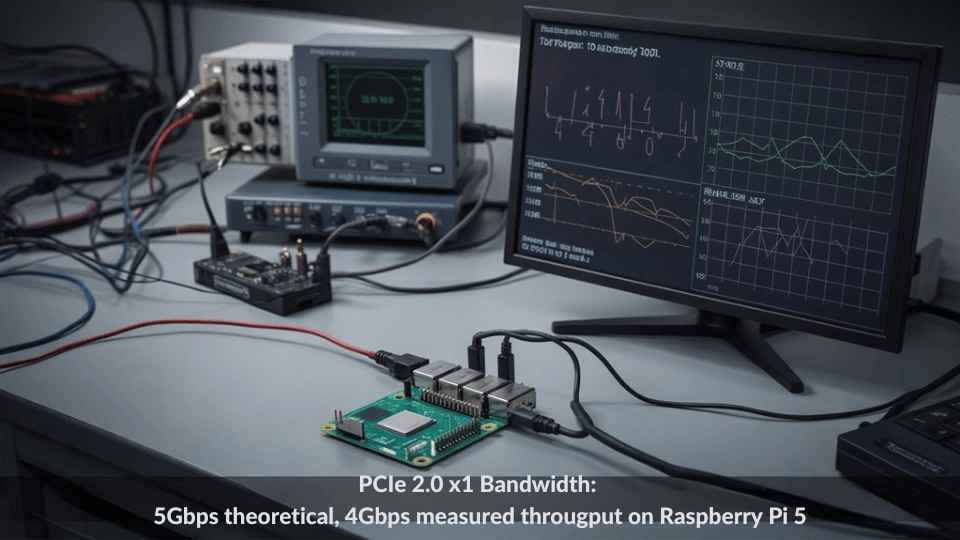You’ve probably heard claims about the Raspberry Pi 5‘s performance leap, but what do the numbers actually show? With its quad-core CPU delivering Geekbench 6 scores around 1,600 and VideoCore VII GPU offering 2-3x rendering efficiency, this isn’t just marketing hype. The real-world implications extend beyond raw processing power to memory bandwidth, storage throughput, and thermal efficiency. Let’s examine the concrete Raspberry Pi 5 performance benchmarks that define this evolution.
Key Takeaways
- Raspberry Pi 5’s CPU offers up to 3x performance improvement over Pi 4, with Geekbench 6 scores averaging 1,600.
- VideoCore VII GPU delivers 2-3x rendering efficiency gains, supporting dual 4Kp60 displays and OpenGL ES 3.1.
- Memory bandwidth doubled with LPDDR4X-4267, showing write speeds of 29,355 MBps (6.7x improvement over Pi 4).
- Storage performance reaches 400-500MB/s with PCIe Gen 2 NVMe integration, offering 3-4x better IOPS than SD cards.
- Networking achieves near-theoretical maximum Gigabit Ethernet throughput (~940 Mbps) with reduced latency across all interfaces.
CPU Performance: 3x Faster Than Pi 4
The Raspberry Pi 5’s CPU delivers exceptional performance gains, outpacing its predecessor by up to 3x in various benchmarks. With Geekbench 6 scores averaging 1,600, the Pi 5 demonstrates substantial performance improvements across both single and multi-threaded workloads.
Impressive 3x performance leap puts the Pi 5 in a different league for both single and multi-threaded tasks
You’ll notice the architecture upgrade from Pi 4’s 1.5GHz Cortex-A72 to Pi 5’s 2.4GHz Cortex-A76 cores dramatically enhances computing capability. Single-thread operations show 1.5-3x improvements, with Geekbench 6 revealing roughly 3x single-core performance increases.
Multi-threaded workload comparisons demonstrate similar gains—Sysbench throughput jumps from 2794 MBps to 4165 MBps, while Bzip compression times approximately halve.
These benchmarks translate to real-world benefits: GIMP image processing accelerates by 2.24-2.36x, and system responsiveness markedly improves during multitasking scenarios. When overclocked from 2.4GHz to 3.0GHz, the Pi 5 achieves a single-core score of 906 while showing more modest gains in multi-core performance. The PassMark benchmark further confirms this trend, showing an impressive 4x faster CPU performance compared to the Raspberry Pi 4.
GPU Capabilities: VideoCore VII Benchmark Results
While CPU advancements show remarkable improvements, Raspberry Pi 5’s VideoCore VII GPU represents another significant performance leap. The new integrated graphics architecture delivers 2-3× better rendering efficiency compared to its predecessor, with benchmarks confirming this substantial gain.
| Benchmark | Score | Improvement |
|---|---|---|
| Sling Shot (ES 3.0) | 1650 | ~2.5× |
| Sling Shot Graphics | 1435 | ~2.7× |
| Sling Shot Extreme | 1070 | ~2.2× |
| Extreme Graphics | 900 | ~2.4× |
| FP32 Compute | 76.8 GFLOPS | ~2× |
You’ll experience stronger gaming potential with the 12-core design running at 800MHz, though compute limitations remain. The GPU architecture supports dual 4Kp60 displays and OpenGL ES 3.1, optimized for desktop workloads rather than intensive computing. Performance optimization focuses on everyday graphics tasks despite modest theoretical FLOPS. When compared to more powerful options like the ARM Mali-G78 MP24, the VideoCore VII shows significantly lower performance, scoring 582% below in standard benchmarks. The VideoCore VII offers no double precision capabilities, limiting its use in scientific applications requiring high numerical accuracy.
Memory Bandwidth: LPDDR4X Speed Improvements

You’ll notice an immediate difference in the Raspberry Pi 5‘s memory performance, thanks to its LPDDR4X-4267 implementation delivering more than double the bandwidth of its predecessor.
Benchmark results confirm this advantage with Passmark Memory Mark showing a 101% increase, while some RAMspeed tests report even more dramatic improvements between 373-560% for specific operations.
The enhanced memory subsystem creates significant parallelism advantages, allowing the new 64-bit quad-core Arm Cortex-A76 processor to maintain higher sustained throughput across data-intensive workloads.
This memory upgrade combines with the 3x performance boost from the upgraded processor to deliver a dramatically improved user experience for demanding applications like media encoding and AI tasks.
Customers can choose from multiple memory configurations including 2GB, 4GB, and 8GB RAM options to best match their specific performance needs and budget constraints.
LPDDR4X-4267 Bandwidth Analysis
Four key improvements make LPDDR4X-4267 memory a significant upgrade for the Raspberry Pi 5. The doubling of data rates to 4267 MT/s delivers theoretical bandwidth of 8.53 GB/s per channel, potentially reaching 34 GB/s with four channels.
You’ll notice this directly impacts multimedia processing and data-intensive workloads.
The 60% voltage reduction to just 0.6V dramatically cuts power consumption while maintaining peak performance—critical for your embedded projects where thermal management matters.
Sophisticated termination and ZQ calibration techniques guarantee signal integrity at these higher speeds.
The memory is available in various density options ranging from 4Gb to 64Gb to accommodate different application requirements.
For maximum bandwidth utilization, the Pi 5 leverages channel interleaving, though actual performance varies from 3.3 GB/s to 22.6 GB/s depending on workload patterns.
Performance optimization requires understanding how memory channels bind to CPU cores, which varies by specific SoC implementation.
Benchmark testing shows that bandwidth performance can significantly fluctuate based on CPU load conditions, with optimal results achieved when system load is minimal.
RAM Read/Write Benchmark Breakdown
The benchmark results reveal extraordinary RAM performance improvements in the Raspberry Pi 5, with write speeds reaching 29,355 MBps—a remarkable 6.7× increase over the Pi 4’s 4,391 MBps.
Read speeds have similarly jumped to 27,931 MBps, representing a 4.7× improvement.
You’ll notice write speed gains surpass read speed enhancements, suggesting targeted optimization of write channels.
While sequential transfers show dramatic improvement, random 4K read performance remains nearly unchanged—indicating optimization focused on large block transfers.
These memory improvements directly contribute to the Pi 5’s halved boot times and enhanced responsiveness. The Pi 5’s boot time has decreased from 35 seconds on the Pi 4 to under 20 seconds, demonstrating the real-world impact of these memory enhancements.
The switch from LPDDR4 to LPDDR4X memory in the Raspberry Pi 5 has contributed significantly to these performance gains.
The consistent performance across both 2GB and 8GB variants confirms that bandwidth improvements stem from architectural enhancements rather than merely increased memory capacity or frequency.
Memory Parallelism Advantages
While architectural improvements throughout the Pi 5 contribute markedly to performance gains, the adoption of LPDDR4X-4267 SDRAM stands as a transformative upgrade over the Pi 4’s LPDDR4-3200 memory.
You’ll experience approximately 33% higher theoretical bandwidth, enabling superior parallel performance across the quad-core Cortex-A76 CPU. The 2-3× faster performance compared to the Pi 4 is directly attributable to these memory improvements working in concert with the upgraded CPU architecture. The combination of 512KB per-core L2 and 2MB shared L3 cache enhances memory efficiency through reduced DRAM access frequency.
For memory-intensive workloads like computational fluid dynamics or large language model processing, bandwidth scaling is substantially improved through LPDDR4X’s high-speed burst transfers.
The RP1 southbridge further complements these advantages by offloading I/O operations, reducing memory bus contention and improving overall data throughput. Available in multiple RAM options ranging from 2GB to 16GB, the Raspberry Pi 5 can be tailored to different application requirements.
This architectural synergy means sustained cache utilization under multithreaded workloads with minimal thermal throttling compared to previous generations.
Storage Performance: SD Card vs. NVMe Options

Storage performance on the Raspberry Pi 5 presents a significant decision point between traditional microSD cards and newer NVMe options via PCIe.
While the Pi 5 supports microSD speeds up to 100MB/s—with SanDisk Extreme Pro A2 and Kingston Canvas Go Plus leading in reliability—this pales compared to NVMe potential.
The newly introduced PCIe Gen 2 x1 interface enables NVMe integration via adapters, delivering 4-5x higher throughput (400-500MB/s) and 3-4x better IOPS than even premium SD cards.
This dramatic difference impacts OS responsiveness and I/O-intensive workloads.
Despite NVMe affordability improving, implementation requires additional hardware and power management consideration.
Most users still opt for microSD convenience, but if you’re pushing performance boundaries, the NVMe route delivers substantial gains worth the added complexity. The boot times improve significantly with NVMe drives, making the Pi 5 more viable as a desktop alternative.
For demanding tasks like multimedia editing or server applications, a fast SD card is essential to prevent system bottlenecks that slow performance.
Thermal Management Under Heavy Workloads
Your Raspberry Pi 5 will operate at approximately 65°C idle without cooling and can reach the 85°C thermal throttling threshold under sustained loads, necessitating active cooling for peak performance.
The official active cooler reduces temperatures considerably during stress tests, keeping the CPU around 58-59°C and preventing performance degradation that occurs when the SoC exceeds temperature limits. Initial testing revealed a dramatic temperature drop from 83°C to 43.5°C immediately after installing the active cooler.
Overclocking beyond the standard 2.8GHz requires proper cooling solutions to maintain system stability and avoid thermal shutdowns that occur when pushing the processor beyond its thermal design parameters. The new PCIe 2.0 connector allows for additional cooling hardware integration when attempting to reach the maximum 3GHz CPU potential.
Temperature Thresholds and Throttling
Understanding the thermal boundaries of the Raspberry Pi 5 begins with its clearly defined temperature thresholds, which dictate performance scaling under load. The SoC’s maximum thermal threshold sits at 85°C, with progressive throttling activating between 80-85°C to protect hardware integrity while maximizing performance. The system’s fan speed management activates at specific temperature thresholds of 60°C, 67.5°C, and 75°C.
| Temperature | System State | Performance Impact |
|---|---|---|
| Below 80°C | Normal Operation | Full performance available |
| 80-85°C | Progressive Throttling | CPU cores throttled first |
| Above 85°C | Full Throttling | Both CPU and GPU clocks reduced |
You’ll notice temperature stabilizes slightly above 85°C without cooling during heavy workloads, though idle temperatures typically hover around 65°C. Even when fully throttled, Pi 5 outperforms a Pi 4 at its thermal limits. Consider active cooling solutions to maintain operations below throttling thresholds for peak performance. The Pi 5’s specialized Active Cooler provides optimal thermal management when running computationally intensive applications.
Cooling Solutions Comparison
With thermal thresholds and throttling behavior established, selecting an appropriate cooling solution becomes a key factor in maintaining the Raspberry Pi 5’s performance envelope.
You’ll find thermal performance varies remarkably between passive, active, and hybrid approaches, with each offering distinct tradeoffs in cooling efficiency and environmental impact.
- Passive solutions (aluminum cases, basic heatsinks) offer silent operation suitable for light workloads but struggle when ambient temperatures rise, limiting overclocking strategies. The FLIRC case exemplifies this approach with its minimalist design that maintains impressive thermal performance for desktop projects. The Passive Cooling Open CNC Case demonstrates this approach with its grooved aluminum sections that dissipate heat effectively without any moving parts.
- Active cooling with fans maintains sub-60°C temperatures under sustained loads, though fan noise varies considerably between models.
- Hybrid tower coolers with heatpipes deliver superior airflow dynamics and consistent 49-50°C temps even under full load, justifying their higher cooling costs for performance-critical applications.
Overclocking Thermal Impacts
Overclocking the Raspberry Pi 5’s CPU releases substantial performance gains, but it simultaneously generates thermal challenges that require careful management. Your cooling solutions directly impact sustained performance under load, with inadequate thermal management triggering throttling that negates overclocking benefits.
| Overclock Level | Temperature Range | Cooling Requirement |
|---|---|---|
| 2.6 GHz (Safe) | <70°C | Passive cooling |
| 2.8 GHz (Moderate) | 70-80°C | Active cooling |
| 3.0 GHz (Aggressive) | >80°C | High-RPM fans |
When implementing overclocking strategies, remember that workload impacts are significant. CPU-intensive tasks like kernel rebuilds quickly push temperatures beyond 80°C without proper cooling solutions. For stability considerations, maintain temperatures below 70°C to prevent thermal throttling and potential system crashes, especially during extended performance gains.
Power Efficiency: FLOPS per Watt Analysis
The power efficiency of Raspberry Pi 5 demonstrates mixed results when analyzing computational performance relative to energy consumption. Achieving approximately 2.75 GFlops per watt, the Pi 5 delivers a 50% improvement over previous generation models, though competitors like Rock 5 Model B and Orange Pi 5 offer nearly double the flops efficiency.
Under multi-core workloads, you’ll observe power scaling that reaches 11.6 watts with performance governor settings, while maintaining competitive efficiency metrics within the Pi ecosystem.
Idle power consumption ranges from 2.4W (2GB model) to 3.3W (8GB model).
24-25 GFlops performance using HPL benchmark represents solid computational capability.
Full-load efficiency matches Libre Computer Alta at approximately 194 points per watt.
Networking Performance: Gigabit Ethernet and Wi-Fi Benchmarks

Networking capabilities of the Raspberry Pi 5 receive substantial upgrades compared to previous generations, delivering performance metrics that reflect its enhanced architecture. The native Gigabit Ethernet now achieves near-theoretical maximum throughput (~940 Mbps) thanks to PCIe Gen 3 implementation, eliminating previous USB 2.0 bottlenecks. Network protocol optimizations manifest in reduced latency and jitter across all interfaces.
| Interface | Max Throughput | Latency | Stability | Upgrade Path |
|---|---|---|---|---|
| Native GbE | 940 Mbps | Excellent | High | – |
| Wi-Fi 6 | 400-600 Mbps | Good | Stable | – |
| USB3 2.5GbE | 2.35-2.5 Gbps | Very Good | High | RTL8156BG |
| PCIe 10GbE | 5-6 Gbps | Excellent | Driver-dependent | M.2 Adapters |
| Native Wi-Fi | 802.11ax | Improved | Better range | Bandwidth management strategies |
Real-World Gaming Performance Metrics
You’ll find dramatically improved classic gaming performance on the Pi 5, with 2D titles and older emulators running at full speed across all memory configurations.
Real-time strategy games benefit from the 1.5x CPU improvements, though the relatively modest GPU gains (only 2x over Pi 4) still create bottlenecks during complex rendering tasks.
Emulation testing reveals a capability spectrum where PS1, Dreamcast and N64 titles run flawlessly, while GameCube/Wii games show mixed results with simpler titles maintaining playable framerates and graphically intensive games struggling despite the Pi 5’s enhanced memory bandwidth.
Classic Gaming Performance
When compared to previous Raspberry Pi models, the Pi 5 delivers considerably improved classic gaming performance across multiple benchmarks and real-world scenarios. The VideoCore VII GPU provides roughly double the graphical performance, with glmark2 benchmarks at 1080p confirming a 2x improvement over the Pi 4.
- Emulation compatibility has expanded considerably, with GameCube and Wii games now running reasonably well, though performance bottlenecks remain for graphically complex titles.
- CPU improvements of 1.5-2× boost emulation quality, particularly for physics and AI processing in classic games.
- Higher RAM configurations (4GB/8GB) demonstrate superior stability compared to 2GB variants, especially when managing demanding emulators like Dolphin.
Despite these gains, GPU constraints still limit performance in graphically intensive classics like F-Zero GX and Star Wars Rogue Squadron 2.
Real-Time Strategy Benchmarks
Real-time strategy games represent a distinct performance challenge compared to classic emulation, as they demand both computational power and predictable timing.
Your Raspberry Pi 5 delivers impressive performance metrics with the PREEMPT_RT patch reducing maximum scheduling latency to 125 microseconds—a 294× improvement over unpatched versions.
The Pi 5’s CPU demonstrates 2-3× faster performance than its predecessor, with multi-threaded benchmarks showing 10,912 events versus the Pi 4’s 7,068.
This enhancement markedly benefits AI calculations and simulation processes essential for RTS gameplay.
While approaching true RTOS capabilities, current RTS emulation tests reveal the Pi 5 can maintain 60 FPS but still exhibits occasional frame hitches.
The deterministic kernel behavior minimizes jitter and scheduling delays, creating a more stable platform for resource-intensive strategy titles.
Emulation Capabilities Tested
Testing various emulation workloads on the Raspberry Pi 5 reveals significant performance disparities between RAM configurations, with memory becoming the critical bottleneck for high-end gaming experiences.
Your emulation performance with the 2GB model proves adequate for older systems but falls short with GameCube titles like Star Wars Rogue Squadron 2, where you’ll encounter single-digit FPS and audio sync issues.
- Memory constraints become evident during Dolphin compilation, where the 2GB variant locks up entirely while 4GB+ models compile seamlessly.
- Stability benchmarks confirm PlayStation 1, Dreamcast, and N64 form the “sweet spot” across all Pi 5 variants.
- Cross-compiling strategies offer workarounds for 2GB users by preparing binaries on higher-RAM models.
For serious emulation enthusiasts, the 4GB or 8GB Pi 5 delivers substantially higher game compatibility and consistent framerates. Additionally, the budget considerations dictate that investing in higher RAM models is crucial for optimal performance in demanding applications.
AI and Machine Learning Inference Speeds
The fifth-generation Raspberry Pi demonstrates remarkable advancements in AI inference capability, establishing itself as a viable platform for edge computing applications. Benchmark tests reveal impressive speedups across model classes, with Resnet50 inference time dropping from 534ms to 96ms in single-threaded operations—a 5.5x improvement over Pi 4.
For edge inference applications, you’ll appreciate the Pi 5’s ability to process YOLOv8n at approximately 12fps at 640×640 resolution, enabling practical real-time object detection deployments.
The board successfully runs 2B-parameter LLMs with manageable latency while consuming only 3-6GB RAM.
AI optimization strategies should leverage llama.cpp over Ollama for resource efficiency. Utilize Vulkan acceleration and prioritize engines with proper quantization support to maximize inference throughput while maintaining system responsiveness during concurrent operations.
PCIe Expansion Throughput Testing

With the introduction of PCIe Gen 3 x1 connectivity, Raspberry Pi 5 establishes itself as a viable platform for high-throughput storage applications previously impossible on earlier models.
Your NVMe SSDs can achieve impressive speeds of 700MB/s reads and 350MB/s writes—more than doubling the performance of identical drives connected via USB 3.0 enclosures.
- Native PCIe NVMe connections deliver 2-3x throughput compared to USB 3.0 external enclosures (700MB/s vs 340MB/s reads)
- Using a PCIe switch like the ASM1184e enables multi-device setups but limits throughput to Gen 2 speeds
- RAID 0 configurations with four NVMe drives peak around 430MB/s total throughput due to PCIe switch limitations
This performance comparison clearly demonstrates that direct PCIe connectivity transforms the Pi 5 into a capable storage server despite the single-lane limitation.
Frequently Asked Questions
How Does Raspberry Pi 5 Compare to Intel NUC or Mac Mini?
Pi 5’s performance trails behind Intel NUC and Mac Mini considerably. You’ll get 2-3x less CPU power, weaker GPU capabilities, limited memory bandwidth, and slower storage options than these desktop-class alternatives.
Can Pi 5 Run Windows 11 ARM Effectively?
You can run Windows 11 ARM on Pi 5, but expect compromised Windows performance due to driver limitations. ARM compatibility exists technically, but networking and GPU acceleration remain restricted, requiring workarounds for effective use.
Is Pi 5 Suitable for Cryptocurrency Mining?
Is Pi 5 Suitable foAll that glitters is not gold. Your Pi 5 isn’t suitable for cryptocurrency mining due to extremely low profitability analysis results and poor mining efficiency compared to ASICs. It’s better for educational purposes only.r Cryptocurrency Mining?
What’s the Typical Lifespan of a Raspberry Pi 5?
Your Raspberry Pi 5’s typical lifespan is 7-10 years with proper care. Its semiconductor durability allows for 10,000 power cycles, while quality components enhance longevity. Continuous operation is viable with proper thermal management.
Does Pi 5 Support Hardware-Accelerated Video Transcoding?
100% of Pi 5 transcoding relies on CPU processing. Your Pi 5 can’t perform hardware-accelerated video transcoding since it lacks a hardware encoder, forcing software-based processing with 40-50% CPU utilization during operations.
Explore Raspberry Pi 5 Performance Benchmarks
You’re witnessing Pi 5’s quantum leap in performance across every benchmark. Like telegram operators upgrading to fiber optics, the 3x CPU boost and VideoCore VII GPU radically transform your computational capacity. You’ll harness 100%+ memory bandwidth improvements, near-saturated Gigabit Ethernet, and NVMe storage hitting 500MB/s. When you’re pushing AI workloads or PCIe expansions, these benchmarks translate directly to your system’s responsiveness and throughput capabilities.
